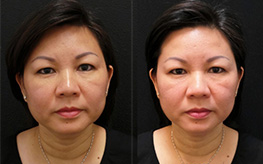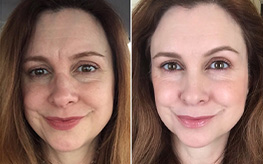Liposuction
Conveniently located to serve the areas of Fountain Valley, CA

Liposuction helps sculpt your body, eliminating unwanted pockets of exercise and diet-resistant fat from the buttocks, hips, love handles, saddlebags, thighs, calves, ankles, breasts, back, arms, and neck. Liposuction is often combined with other procedures to create a desired shape and is one of the safest and most popular cosmetic procedures.
Contents
Considerations
- If you have localized deposits of fat in your abdomen, arms, thighs, and/or neck, which may be the result of heredity.
- If you are bothered by excess fat deposits located anywhere on your body that don’t respond to diet or exercise
- If you have localized areas of fat deposits that are disproportionate with the rest of your body.
- If you would like more definition or a sleeker contour in certain areas of your body.
- You have a minimal amount of excess skin and good skin elasticity. Loss of skin elasticity with age can compromise lipoplasty results, but if your skin maintains elasticity, age alone is not a contraindication for liposuction surgery.
- You have localized deposits of fat in your abdomen, arms, thighs and/or neck, which may be the result of heredity and do not disappear with exercise and diet.
- You are physically fit, no more than 20 pounds overweight, and your weight is stable. If you are planning to lose a significant amount of weight or even gain weight (for example, due to pregnancy), this is not the time to undergo liposuction.
- Keep in mind that liposuction does not remove cellulite and cannot tighten loose skin. Your surgeon will be able to recommend other procedures to improve those conditions.
Benefits
- Will make your clothes fit better and your body appears slimmer.
- Uses small, minimally invasive incisions, which result in smaller scars than open body contouring procedures.
- Can be done under sedation with less risks and shorter operating times than similar open body contouring procedures.
Ideal Candidate
- You are physically fit, no more than 20 pounds overweight, and your weight is stable. (You may need to lose weight to be a better candidate for liposuction.)
- You are within 30% of their ideal weight with good muscle tone.
- Your skin elasticity is good. (Liposuction removes fat but does not tighten skin.)
- You are a healthy individual who do not have a life-threatening illness or medical conditions that can impair healing.
- For certain individuals, diet and exercise will never get rid of stubborn pockets of fat
- You are a non-smoker.
Procedure
Liposuction removes fat from your body using suction. In this procedure, small, thin, blunt-tipped tubes (cannula) are inserted through small cuts in the skin. Your plastic surgeon moves these tubes under your skin to target fat deposits and then suction them out. From traditional liposuction procedures to new laser liposuction technologies such as Smart Lipo, there are a variety of techniques that facilitate liposuction:
- Tumescent liposuction describes a “wetting solution” with a local anesthetic, such as lidocaine and another medication in IV fluids, which is injected before surgery, causing blood vessels to shrink down or constrict. This allows liposuction to be performed with the patient under local anesthesia, minimizes blood loss and reduces postsurgical pain and bleeding.
- Suction-assisted liposuction (SAL), the most traditional form of liposuction, draws fat out with a vacuum.
- Power-assisted liposuction (PAL) is traditional SAL with the addition of a tool to increase the motion of the cannula, which speeds up fat removal.
- Ultrasound-assisted liposuction (UAL) transmits energy through a special hand piece that helps to loosen and melt fat, enabling a greater volume of fat to be removed. This is best for larger areas, dense fat and male patients.
- VASER, a variation of UAL, is an ultrasonic cannula with several grooves that evenly disperse the energy, improving fat disruption and removal.
- Laser-assisted liposuction (LAL), such as Smartlipo and Slimlipo, is a relatively new technology. The theory is that the laser will work like ultrasound-assisted lipoplasty to disrupt the fat cells and make fat removal more efficient and less traumatic.
Safelipo Surgery
Safelipo is a procedure that has been developed by an Aesthetic Society member that involves a 3-step process of separation, aspiration and fat equalization.
- Separation – loosens, emulsifies and separates out the unwanted fat cells without generating heat, so essential blood vessels, skin and other tissues are unharmed
- Aspiration – fat cells are gently removed through suction, without damaging supporting structures such as nerves, blood vessels, skin
- Fat Equalization – smooths out the remaining thin fat layer, leaving behind a uniform layer of ‘local fat grafts’ that prevents contour deformities from forming
Results
The results of liposuction surgery are technically permanent because fat cells have been removed. However, your body shape and contours might be affected by weight gain, aging, pregnancy, family genes, and lifestyle factors.
It is crucial to maintain healthy habits and a stable weight to maintain liposuction results. If you continue to eat excess calories, fat will no longer be stored in the cells that have been removed but will be stored in other body areas.
There is no way to predict where your body will store new fat. What’s more, your surgeon will not remove all of the fat cells from your target area, so you could still increase the size of the remaining fat cells in that area.
Limitations and Risks:
Fortunately, significant complications from fat grafting are infrequent. This procedure is usually performed without any major problems. Risks and potential complications of surgery is a subject you should discuss during your consultation. The risks in most surgeries are similar. Some of the potential complications of all surgeries are:
- Adverse reaction to anesthesia
- Hematoma or seroma (an accumulation of blood or fluid under the skin that may require removal)
- Infection and bleeding
- Changes in sensation
- Scarring
- Allergic reactions
- Damage to underlying structures
- Unsatisfactory results that may necessitate additional procedures
Other risks specific to liposuction are outlined below:
- Indentations
- Contour irregularities



